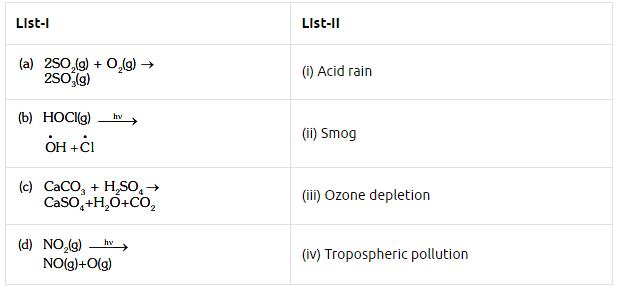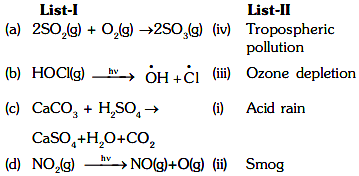NEET Previous Year Questions (2014-2025): Environmental Chemistry (Not in NCERT) | Chemistry Class 11 PDF Download
Q.1. Given below are two statements: (2023)
Statement I: The nutrient deficient water bodies lead to eutrophication
Statement II: Eutrophication leads to decrease in the level of oxygen in the water bodies.
In the light of the above statements, choose the correct answer from the options given below:
A: Both Statement I and Statement II are true.
B: Both Statement I and Statement II are false.
C: Statement I is correct but Statement II is false.
D: Statement I is incorrect but Statement II is true.
Ans: D
Nutrient enriched water bodies support a dense plant population, which kills animal life by depriving it of oxygen and results in subsequent loss of biodiversity. This process is called as eutrophication.
Q.2. The pollution due to oxides of sulphur gets enhanced due to the presence of:
(a) particulate matter
(b) ozone
(c) hydrocarbons
(d) hydrogen peroxide
Choose the most appropriate answer from the options given below: (2022)
A: (b), (c), (d) only
B: (a), (c), (d) only
C: (a), (d) only
D: (a), (b), (d) only
Ans: D
Particulate matter catalyses the oxidation SO2.
Q.3. Match List-1 with List-II (2021)
Choose the correct answer from the options given below.
A: (a)-(iv), (b)-(iii), (c)-(i), (d)-(ii)
B: (a)-(iii), (b)-(ii), (c)-(iv), (d)-(i)
C: (a)-(i), (b)-(ii), (c)-(iii), (d)-(iv)
D: (a)-(ii), (b)-(iii), (c)-(iv), (d)-(i)
Ans: A

Q.4. The incorrect statement about carbon monoxide is- (2020)
A: It reduces the oxygen-carrying ability of blood.
B: The carboxyhaemoglobin (haemoglobin bound to CO) is less stable than oxyhaemoglobin.
C: It is produced due to incomplete combustion.
D: It forms carboxyhaemoglobin.
Ans: B
Carboxyhaemoglobin (symbol COHb or HbCO) is a stable complex of carbon monoxide and haemoglobin (Hb) that forms in red blood cells upon contact with carbon monoxide (CO).
The CO-hemoglobin complex is far more stable than O2 -hemoglobin (oxyhemoglobin)
Hence statement B is incorrect.
Q.5. Which of the following statement is NOT true about acid rain ? (2020)
A: It is due to reaction of SO2, NO2 and CO2 with rain water
B: Causes no damage to monuments like Taj Mahal.
C: It is harmful to plants.
D: Its pH is less than 5.6
Ans: B
Taj mahal yellow coloration is one of the raising issue, one of the prominent reason is acid rain. The Taj mahal is made up of marble i.e CaCO3 , rest you can relate with displacement reaction that may occur with sulphuric and nitric acids, etc.
Q.6. Among the following, the one that is not a greenhouse gas is: (2019)
A: Sulphur dioxide
B: Nitrous oxide
C: Methane
D: Ozone
Ans: A
The primary greenhouse gases present around us are carbon dioxide, methane, nitrous oxide, ozone and water vapours etc. Thus, the gas which is not green house gas from the options given to us is Sulphur dioxide.
Q.7. Which oxide of nitrogen is not a common pollutant introduced into the atmosphere both due to natural and human activity ? (2018)
A: N2O5
B: NO2
C: N2O
D: NO
Ans: A
Nitrous oxide (N2O) occurs naturally in environment.
In automobile engine, when fossil is burnt dinitrogen & dioxygen combine to yield NO & NO2.
Q.8. Which of the following is a sink for CO ? (2017)
A: Microorganisms present in the soil
B: Oceans
C: Plants
D: Haemoglobin
Ans: A
Microorganisms present in the soil.
Q.9. Which one of the following is not a common component of Photochemical Smog? (2014)
A: Peroxyacetyl nitrate
B: Chlorofluorocarbons
C: Ozone
D: Acrolein
Ans: D
Common components of Photochemical smog are peroxyacetyl nitrate, chlorofluorocarbons and ozone etc.
|
114 videos|263 docs|74 tests
|
FAQs on NEET Previous Year Questions (2014-2025): Environmental Chemistry (Not in NCERT) - Chemistry Class 11
| 1. What is Environmental Chemistry and why is it important for NEET? |  |
| 2. Which topics in Environmental Chemistry are frequently covered in NEET exams? |  |
| 3. How can I prepare for Environmental Chemistry questions in NEET? |  |
| 4. What are some common pollutants studied in Environmental Chemistry? |  |
| 5. How does Environmental Chemistry relate to human health? |  |
















